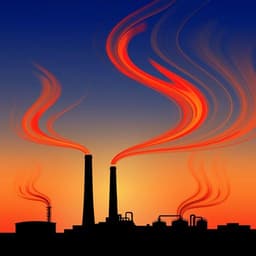Introduction
Hydrofluorocarbons (HFCs), potent greenhouse gases, are regulated under the Kyoto Protocol and the Kigali Amendment to the Montreal Protocol to mitigate climate change. HFC-23, a byproduct of HCFC-22 production, possesses a high global warming potential (GWP). Its atmospheric concentration has risen significantly since the early 1960s. Previous studies, using atmospheric observations and models, showed growth in HFC-23 emissions until 2006, followed by a decline due to emission reduction efforts in developed countries and the UNFCCC Clean Development Mechanism (CDM). Following the end of the CDM period, emissions grew again before showing further declines linked to abatement measures implemented by China and India. This study presents updated global HFC-23 emissions derived from atmospheric observations between 2015 and 2018, as well as a new inventory-based emission estimate incorporating reported emission reductions. The study aims to investigate the discrepancy between expected emissions reductions and observed atmospheric levels of HFC-23.
Literature Review
Prior research, based on atmospheric observations and firn air measurements, documented a rise in global mean HFC-23 mole fraction from near zero in the early 1960s to 28.9 ± 0.6 pmol mol−1 by the end of 2016. These data, combined with atmospheric transport and chemistry models, allowed for the inference of global emissions. These top-down methods indicated emissions growth from 4.2 ± 0.7 Gg yr−1 in 1980 to 13.3 ± 0.8 Gg yr−1 in 2006, followed by a decline to 9.6 ± 0.6 Gg yr−1 in 2009 due to emission reduction efforts. Post-CDM, emissions grew to 14.5 ± 0.6 Gg yr−1 in 2014 before declining again to 12.7 ± 0.6 Gg yr−1 in 2016. These studies laid the foundation for understanding the atmospheric dynamics of HFC-23 and highlighting the need for further investigation into emission trends, especially in the context of mitigation policies.
Methodology
This research employs a two-pronged approach: bottom-up and top-down estimation of HFC-23 emissions. The bottom-up approach utilizes HCFC-22 production data from the UNEP HCFC database and UNFCCC National Inventory Reports (NIRs) for developed countries, combined with emissions factors to estimate HFC-23 emissions. Developing country emissions are estimated using HCFC-22 production data and emissions factors, considering reported emission reductions from the CDM and post-2015 abatement efforts by China and India. The top-down approach leverages in situ HFC-23 measurements from five AGAGE stations, along with a 12-box atmospheric transport model and a Bayesian inversion method to infer global emissions. The Bayesian method incorporates prior constraints, measurement uncertainties, model representation errors, calibration scale uncertainty, and HFC-23 lifetime uncertainty to quantify uncertainties in the emission estimates. The consistency of the results from both the top-down and bottom-up estimation methods are compared to validate the results.
Key Findings
The study reveals a significant discrepancy between expected and observed HFC-23 emissions. While reported emission reductions from China and India were expected to lead to a substantial decline, atmospheric observations show a continued increase, reaching a record high of 15.9 ± 0.9 Gg yr−1 in 2018. The bottom-up estimate, incorporating reported emission reductions, indicates much lower emissions (2.4 ± 0.9 Gg yr−1 in 2017). This substantial difference (12.5 ± 0.7 Gg yr−1) suggests that either the reported reductions haven't been fully implemented, or there's significant unreported HCFC-22 production leading to unaccounted-for HFC-23 emissions. The cumulative difference between top-down and bottom-up estimates from 2015 to 2017 is 24.4 Gg, equivalent to approximately 309 Tg CO2-equivalent emissions—comparable to Spain's total greenhouse gas emissions in 2017. Analysis of the data further shows that the decline in HFC-23 emissions between 2014 and 2016 was less significant than expected based on China's reported reductions. HCFC-22 production increase in 2017 caused a rebound in HFC-23 emissions.
Discussion
The significant discrepancy between reported and observed HFC-23 emissions highlights a substantial gap in the implementation or reporting of emission reduction measures. The findings strongly suggest that either China's reported 98% abatement in 2017 didn't fully materialize, or there's substantial unreported HCFC-22 production, or a combination of both. The magnitude of the discrepancy necessitates further investigation into the accuracy of reported emission reductions and the potential for unaccounted-for HCFC-22 production. The implications of these findings are considerable, highlighting a failure to meet intended emissions reductions and underscoring the need for enhanced monitoring and enforcement of emission control policies. The results emphasize the importance of robust, independent verification of emission reduction claims.
Conclusion
This study reveals a considerable discrepancy between reported and observed HFC-23 emissions, highlighting the inadequacy of current monitoring and reporting mechanisms. The findings point toward substantial unreported emissions, either from incomplete abatement or undocumented HCFC-22 production. This underestimation of emissions represents a significant setback in climate change mitigation efforts. Further research should focus on improving emission reporting accuracy, strengthening enforcement, and developing more effective monitoring strategies. The study underscores the urgency of addressing this gap to achieve effective climate change mitigation.
Limitations
The study's limitations include reliance on reported emission reduction data, which may not accurately reflect actual emissions. The top-down approach relies on atmospheric models, which inherently involve simplifications and uncertainties. The study also did not directly address the source of the extra emissions—whether from incomplete abatement or unreported production. Future research could benefit from more detailed, independent verification of emission data from HCFC-22 production facilities.
Related Publications
Explore these studies to deepen your understanding of the subject.






